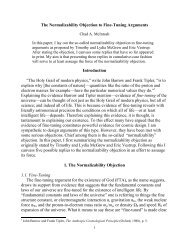Theism and Explanation - Appeared-to-Blogly
Theism and Explanation - Appeared-to-Blogly
Theism and Explanation - Appeared-to-Blogly
You also want an ePaper? Increase the reach of your titles
YUMPU automatically turns print PDFs into web optimized ePapers that Google loves.
150 Appendix<br />
it reasonable—but in a way that is causally “deviant.” 11 Davidson himself<br />
offers an example of this causal deviance.<br />
A climber might want <strong>to</strong> rid himself of the weight <strong>and</strong> danger of holding<br />
another man on a rope, <strong>and</strong> he might know that by loosening his<br />
hold on the rope he could rid himself of the weight <strong>and</strong> danger. This<br />
belief <strong>and</strong> want might so unnerve him as <strong>to</strong> cause him <strong>to</strong> loosen his<br />
hold, <strong>and</strong> yet it might be the case that he never chose <strong>to</strong> loosen his hold,<br />
nor did he do it intentionally. 12<br />
It follows, the objection runs, that we cannot analyse an intentional action<br />
simply in terms of the agent’s beliefs <strong>and</strong> desires.<br />
Richard Swinburne considers this objection <strong>to</strong> be fatal <strong>to</strong> Davidson’s<br />
belief-desire thesis. He argues that on Davidson’s view what causes an intentional<br />
action is some “passive state” of the agent or “some event involving<br />
him.” 13 But, he continues, “if an intention (or wish or desire) of P <strong>to</strong> bring<br />
about E is some passive event or state, it could bring about E without P’s<br />
having intentionally brought about E. Causation by an intention (so unders<strong>to</strong>od)<br />
does not guarantee intentional action.” 14 Swinburne illustrates his<br />
objection with another example of causal deviance, this time from the work<br />
of Richard Taylor.<br />
Suppose . . . that a member of an audience keenly desires <strong>to</strong> attract a<br />
speaker’s attention, but, being shy, only fi dgets uncomfortably in his seat<br />
<strong>and</strong> blushes. We may suppose, further, that he does attract the speaker’s<br />
attention by his very fi dgeting; but he did not fi dget in order <strong>to</strong> attract<br />
the speaker’s attention, even though he desired that result <strong>and</strong> may well<br />
have realised that such behaviour was going <strong>to</strong> produce it. 15<br />
Swinburne’s objection seems correct. Surely, we might argue, it is the agent<br />
who brings about the action, not some mental state which the agent might<br />
happen <strong>to</strong> have. As Swinburne writes, “having an intention is not something<br />
that happens <strong>to</strong> an agent, but something she does.” 16 There is an<br />
insight here that should be preserved. But does it rule out Davidson’s analysis?<br />
Can these two perspectives be reconciled?<br />
I believe they can. They can be reconciled by recognising the existence<br />
of a distinct kind of mental state, which I shall describe as an “intention,” 17<br />
<strong>and</strong> a distinct kind of mental event, which I shall describe as the “formation<br />
of an intention.” 18 An intention is a kind of pro attitude, 19 but it differs<br />
from the pro attitudes that may contribute <strong>to</strong> its formation. It is not merely<br />
a judgement that something is desirable, all things being equal; it is the<br />
judgement that something is <strong>to</strong> be done. 20 As I argued earlier (3.2 <strong>and</strong> 5.2),<br />
an intentional explanation operates by positing an intention, unders<strong>to</strong>od<br />
in this sense, <strong>and</strong> by showing that the action <strong>to</strong> be explained is a rational<br />
one, given that intention. It follows (as Davidson argues) that an intentional



